The Zingaro Nature Reserve, situated on the western coast of Sicily, spans for approximately 7 kilometers.
Positioned between the charming Scopello village and the scenic resort of San Vito lo Capo, the reserve was established through the Regional Law 98/1981, becoming the first of its kind in Sicily to be managed by the regional authority.
The reserve’s creation was a result of a lengthy and complicated bureaucratic process. In the 1970s, a coastal road construction threatened to cause irreversible damage to the environment and the area’s ecosystem.
The remnants of the ill-fated project can still be observed in the tunnel carved into the rock located a short distance after the entrance on the Scopello side.
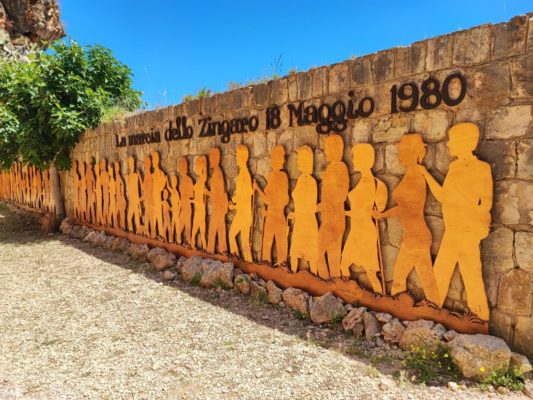
The monument commemorating the protest march
To obtain the suspension of the work and the definitive revocation of the funding, some environmental associations, men of culture and ordinary citizens joined in a protest march in which about 3,000 people participated. It was May 18, 1980.
We highly recommend a visit to the Zingaro Nature Reserve as part of your itinerary when exploring western Sicily.
Regardless of whether you’re an outdoor enthusiast or not, we encourage everyone to experience the reserve’s natural beauty.
In this article, we’ll not only share our personal experiences but also provide useful information and helpful tips to ensure your visit is enjoyable and well-organized.
Table of Contents
- How to Reach Zingaro Nature Reserve
- Entrance hours
- Zingaro Nature Reserve map
- Discovering the Beaches of the Zingaro Nature Reserve
- Trails and Paths
- Zingaro’s Coastal Path: Our Unforgettable Hike
- Museums in the Zingaro Nature Reserve
- The Flora
- The Fauna
How to Reach Zingaro Nature Reserve
To access the Zingaro Nature Reserve, there are two primary entry points: the Southern entrance, located a few kilometers past Scopello, and the Northern entrance, situated approximately twelve kilometers from San Vito lo Capo.
It’s important to note that there is no direct road linking the two entrances.
If you enter from the Southern point, you’ll need to double back to the Guidaloca beach, take the SS187, and travel for approximately fifteen kilometers before turning right toward Custonaci, Macari, and San Vito lo Capo.
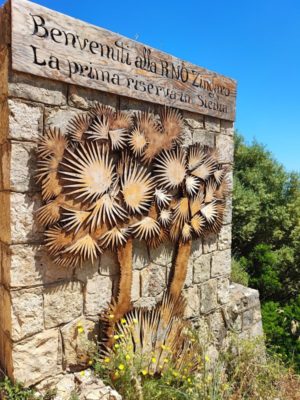
The South entrance
At both entrances, visitors will find ample parking space and designated picnic areas to enjoy.
Entrance tickets can be purchased on-site at the appropriate kiosks. The standard rate for admission is €5.00 for adults and €3.00 for reduced admission.
Special rates are available for school groups, and certain categories, such as children under the age of 10 and individuals over the age of 65, are eligible for free entry.
Restroom facilities are available at the Naturalistic Museum, the Environmental Education Center and the Museum of Maritime Activities.
Entrance hours
The Zingaro Nature Reserve operates on regulated entrance hours, which vary by season:
- During the summer months, the entrance is open from 7:00 a.m. to 7:30 p.m.
- In the winter season, the entrance is open from 8:00 a.m. to 4:00 p.m.
Zingaro Nature Reserve map
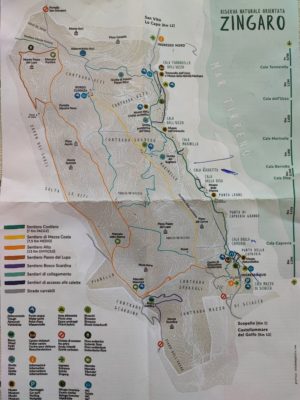
Zingaro Nature Reserve map
Discovering the Beaches of the Zingaro Nature Reserve
The Zingaro Nature Reserve boasts a rugged coastline featuring exquisite coves perfect for sunbathing and swimming in the crystal-clear waters of the sea.
Accessible via short detours from the coastal path or by sea, these seven pebble and gravel beaches offer visitors a stunning seaside experience. We’ve listed them from south to north below.
On the South side:
- Cala della Capreria, located 1.4 kilometers from the South entrance, takes approximately 20 minutes to reach without stops.
A narrow and steep path branches off from the main path a few hundred meters after the Naturalistic Museum and descends down to the sea.
- Cala del Varo, approximately 2 kilometers from the south entrance, can only be reached by sea.
Visitors can either rent a boat or join one of the many day trips from Scopello, Castellamare del Golfo, and San Vito lo Capo that stop at Cala del Varo.
The Manna Museum is situated just above the beach, along the coastal path.
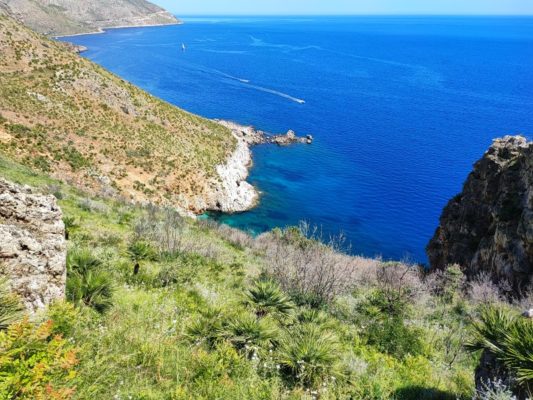
Cala del Varo beach
In the Central Area:
- In the heart of the reserve, these three beaches are located close to each other: Cala della Disa, Cala Berretta (which is halfway between the southern and northern entrances), and Cala Marinella.
The latter is a small and sheltered beach where visitors will need to lay down on the rocks.
On the North Side:
- Cala dell’Uzzo is located about 2 kilometers from the north entrance of the reserve and is named after the nearby cave of the same name.
This pebbled cove has crystal-clear waters and is ideal for swimming and snorkeling.
- Cala Tonnarella dell’Uzzo is considered to be the most beautiful beach in the reserve and is just 15 minutes from the North entrance.
It is the most popular beach among visitors during the summer months and can be reached by a staircase carved into the rock.
The building housing the Museum of Maritime Activities is located right next to it.
Trails and Paths
There are three main trails that can be explored on foot within the Zingaro Nature Reserve: Coastal Path, Mezzacosta, and High Trail.
The Coastal Path, which is the easiest of the three, is the most popular among hikers and tourists.
It stretches for about 7 kilometers and takes around two hours to complete without any stops, from one entrance to the other.
The best time to visit is during the shoulder seasons when the weather is mild and sunny without being too hot.
During spring and autumn, the flora in the reserve is at its best, showcasing a beautiful array of colors and flowers.
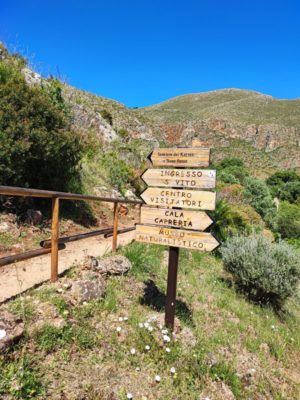
Directional signs along the Coastal Path
The Mezzacosta path, on the other hand, is rated as a moderate difficulty trail, with a total length of about 7.5 kilometers and takes about 4 hours to complete.
It’s the most picturesque among the three paths and passes through the villages of Borgo Cusenza and Contrada Sughero.
Finally, the High Trail is the most difficult and is recommended for experienced hikers. It’s a challenging 13-kilometer route that takes about 7 hours to complete.
Additionally, there are also several well-marked secondary paths that branch off from the primary trails, providing hikers with many options for customizing their itineraries.
The paths are all clearly marked on maps and directional panels, making it easy to navigate through the reserve.
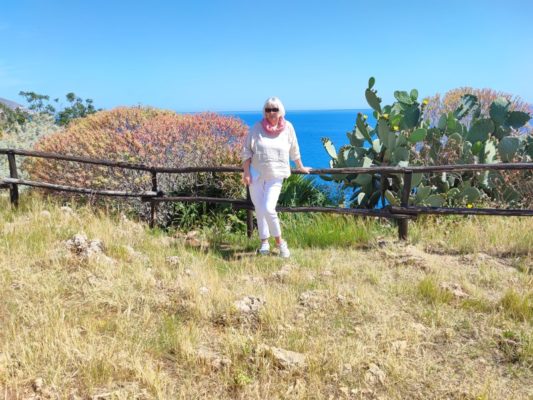
Mediterranean Scrub
Zingaro’s Coastal Path: Our Unforgettable Hike
We started our journey from the south entrance and walked to Cala Beretta and back, taking approximately two and a half hours.
After parking our car in the dirt clearing near the ticket office, we set out on the Coastal Path early in the morning on a wonderful sunny day in mid-May.
Before entering the wilderness, we stopped at some information panels to learn about the history and challenges that led to the creation of the reserve.
Once we passed through the famous tunnel, the trail became considerably narrower and continued with continuous ups and downs.
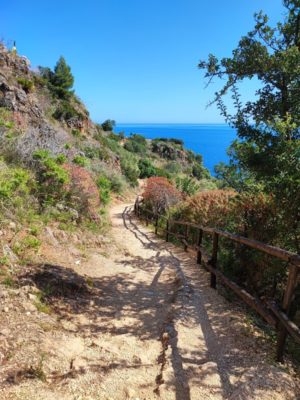
The Coastal Path
The path has a gravel and rocky surface, and in the most exposed areas, it is bordered by a wooden fence.
From the very beginning of the reserve, you can admire its wonders, with the stunning contrast between the white rocks, the blue sea, and the soft red soil.
The main route and its deviations are well-marked with wooden directional signs, but if you plan to cover a significant distance, you should have a minimum level of fitness and preparation.
The ticket office provides estimated travel times: 20 minutes to Cala Capreria, one hour to Cala Beretta, and about two hours to reach the San Vito entrance.
However, based on our personal experience, we recommend taking all the time you need to fully appreciate this paradise.
Only then can you leave with an unforgettable memory.
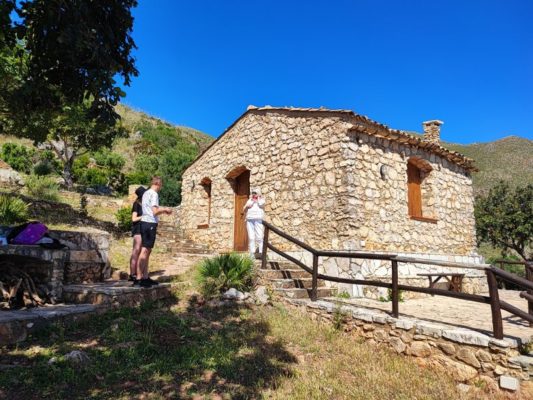
Forest Guards’ refuge
During our hike on the coastal path, we made several stops along the way.
At the forest shelter, we chatted with two Polish boys and enjoyed some delicious raspberries.
We also visited the Naturalistic Museum and the Manna Museum to learn interesting facts about the area.
In addition, we took short breaks to capture some breathtaking views, including the picturesque beach of Capreria. Finally, we stopped to hydrate ourselves and refuel with some snacks.
Information
To ensure a safe and enjoyable experience on the Zingaro Nature Reserve Trails, we recommend the following:
- wear comfortable and sturdy shoes, and consider bringing a cap or hat to protect yourself from the sun;
- apply sunscreen to prevent sunburn, especially on sunny days;
- bring an adequate supply of water and easy-to-digest snacks, as there are no drinking water sources available in the reserve;
- consider using trekking poles if you have them, as the terrain can be uneven in some areas.
It’s important to note that inappropriate footwear such as sandals and flip-flops are not permitted on the trail.
We strongly advise against attempting the trail without proper footwear, as it could result in injury or discomfort.
We have witnessed individuals attempting the trail in these types of footwear and do not recommend it.
Museums in the Zingaro Nature Reserve
The Zingaro Nature Reserve boasts five fascinating and compact museums.
As you enter from the South, you’ll come across the Naturalistic Museum after approximately twenty minutes.
A little further along, above Cala del Varo, you’ll spot the charming stone building that houses the Manna Museum.
We personally visited both of them.
The Naturalistic Museum is housed in a small structure with white walls and is encircled by a courtyard lined with a wooden fence that faces the sea.

The exterior of the Naturalistic Museum
We recommend taking a moment to appreciate the surroundings before entering the Naturalistic Museum, where you can see stunning prickly pear, euphorbia plants, and dwarf palms.
You can sit on a simple wooden bench and enjoy the picturesque landscape, a refreshing experience for both the body and the mind.
Inside the museum, you can learn about the reserve’s flora and fauna and the composition of its subsoil.
The animal sculptures on display were created by modeling a galvanized mesh, then covering it with gauze dipped in plaster and finally finishing it with clay.
The Manna Museum, on the other hand, showcases the history of manna cultivation in Sicily, which likely dates back to the period of Arab domination in the 9th-11th centuries AD.
Sicily was once the largest producer of manna in the world, thanks to the vast ash plantations in Trapani and Palermo.
Manna is extracted from the ash tree by making incisions on the trunk of the plant between the end of July and the beginning of September.
Afterward, it is left to dry for a week on special racks.
Manna has both pharmaceutical properties, as an excellent natural laxative, and is used as a sweetener in food.
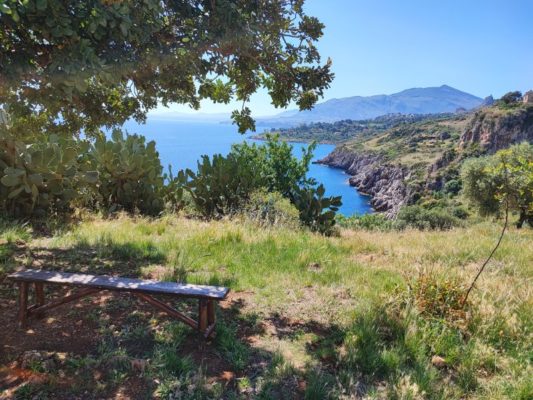
Zingaro Nature Reserve panorama
If you enter the reserve from the San Vito side, you will find three museums.
The first is the Museum of Maritime Activities, located in a building that was previously used to process tuna.
The second is the Museum of Weaving, and the third is the Museum of Rural Civilization. The latter showcases the entire wheat cycle and illustrates the agricultural traditions of the area.
The Flora
The Mediterranean scrub is the most notable characteristic of the flora found in the Reserve, which consists of shrubs, indigenous plants, and uncommon species.
The dwarf palm scrub is a type of shrubbery vegetation that thrives along the rocky shores, impacted by the effects of the winds.
On the other hand, the calcareous rocky crests and dry hillsides provide an ideal environment for shrubs such as arborescent euphorbia, mastic, olive, and stink wood.
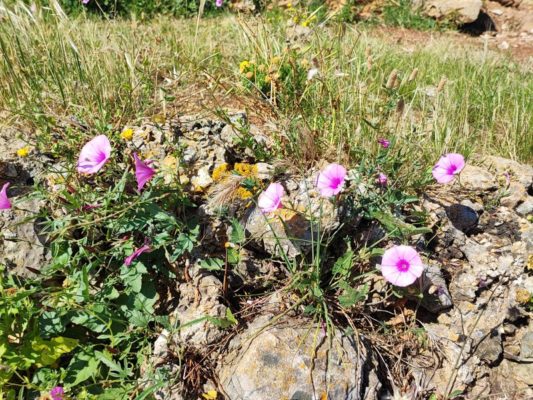
The flora
The Zingaro Nature Reserve is home to not only the Mediterranean scrub but also several endemic and rare plant species.
Some of the endemic plants include the Sicilian snapdragon, yellow cornflower, Iberide florida, Coppoler garlic, and Branciforti orchid.
These plants, along with rare species, are the most valuable aspect of the flora found in the area.
Some of the rare species include the spinulosa cerretta, autumn bells, Cupani colchico, Sicilian ofride, red violaciocca, and bion of Bivona.
The Fauna
The Zingaro Nature Reserve is home to a diverse range of animals, with avifauna being the most prominent group, boasting more than 40 resident species, along with those that come to winter or stop during seasonal migrations.
Reptiles found in the Reserve include lizards, snakes, and common vipers, while birds such as tawny owls, owls, kestrels, and Bonelli’s eagles also make their home there.
The reserve is also home to rodents such as the quercino and porcupine, as well as other animals including wild rabbits, foxes, hedgehogs, and weasels.



0 Comments